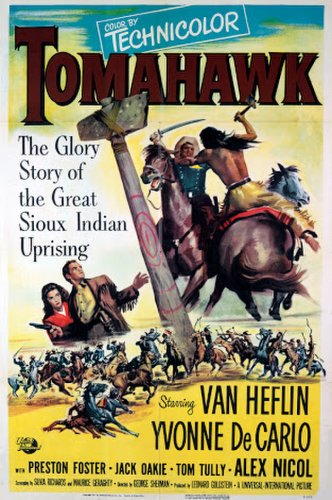

When Dancy is shot and killed by an arrow, padding can clearly be seen beneath his shirt.
When Red Cloud attacks the soldiers with their new rifles, the weather changes; when Red Cloud is getting ready to attack, there are dark storm clouds behind the Indians; in the next scene, minutes later, there are only a few scattered clouds in a mostly sunny sky.
A sympathetic examination of the poor treatment of the Sioux in the 1860s is more historically accurate than most Westerns from this era, but is fairly tepid when it comes to dramatic content. Van Heflin lacks presence, and shares an inconsequential romance with Yvonne De Carlo, who serves no purpose other than to look improbably glamorous.
It's 1866 in the Wyoming territory, and the US government is trying to forge a treaty with the Sioux for access through the region to gold-rich Montana. The natives reluctantly agree thanks to the intervention of white friend-to-the-Indian Jim Bridger (Van Heflin).
Veteran western director George Sherman's "Tomahawk" qualifies as a predictable but entertaining, Blue coats versus the Redskins horse opera. Van Heflin toplines this Technicolor tale as a savvy cavalry scout, Jim Bridger, who aligns himself with the U.
Battle of Powder River (AKA: Tomahawk) is directed by George Sherman and adapted for the screen by Sylvia Richards & Maurice Geraghty from a story by Daniel Jarrett. It stars Van Heflin, Yvonne de Carlo, Alex Nicol, Preston Foster, Jack Oakie, Tom Tully, John War Eagle and Susan Cabot.
Having seen and reviewed several films dealing with various aspects of the Powder River Bozeman Trail(Red Cloud)War of 1866-8, whether or not acknowledged as such, it was refreshing to find a Hollywood cavalry western that was much more of a documentary treatment than these later films. Directed by George Sherman, who specialized in short "B" westerns and other films for Universal, it was mostly shot in the Black Hills of SD, which rather resemble the neighboring Powder River region of WY.
It's a spiffy little Universal 'shaky A' western, starring Van Heflin as Jim Bridger, and Jack Oakie as his sidekick: scouts, traders, and bridges between the Amerindians of the Old Northwest and the Washington government. Here's it's the Black Hills of Dakota, shot on site with some dazzling skies, thanks to cinematographer Charles Boyle.
Interesting western in that for a 1951 film, the white men for the major part are cast as the villains of the piece, continually ignoring earlier treaties with the Sioux and initiating aggressions that we understand will cause the Sioux to react aggressively themselves. The script also introduces a number of historical figures and incidents into the storyline, though plenty of liberties are taken with this "timeline" to ensure a smooth and dramatic narrative.
This great 1951 western just seems to get better with age. Having seen the film many times over the years but again today on TV, I really think this is one of the best westerns of the period and one that stands the test of time.
A famous trapper by the name of "Jim Bridger" (Van Heflin) signs on as scout under the command of "Colonel Carrington" (Preston Foster) to assist him at a small fort in Sioux Country. While he has every intention of assisting the colonel, he also has an ulterior motive and that is establish if the killer of his Cheyenne wife and son is a cavalry officer named "Lt.